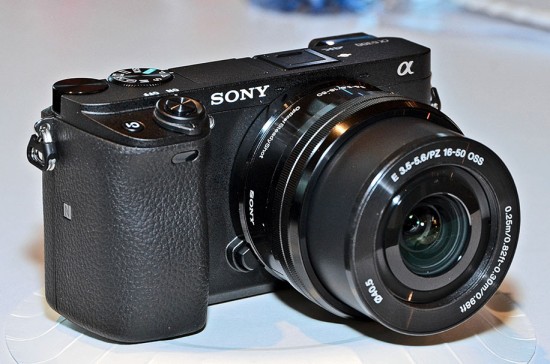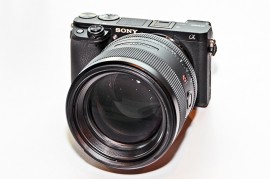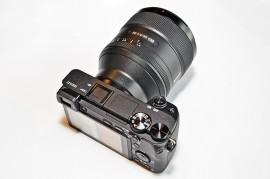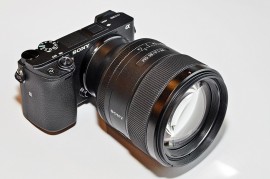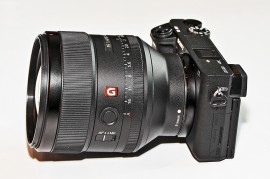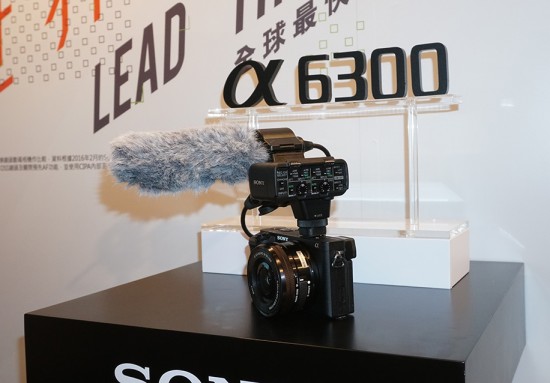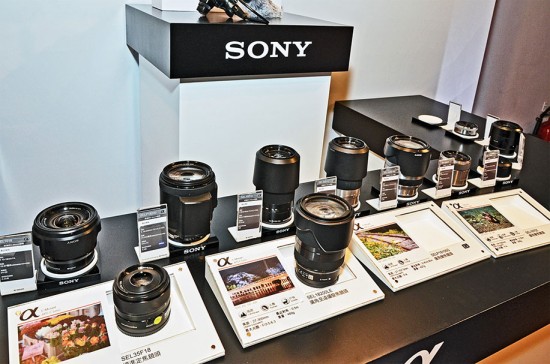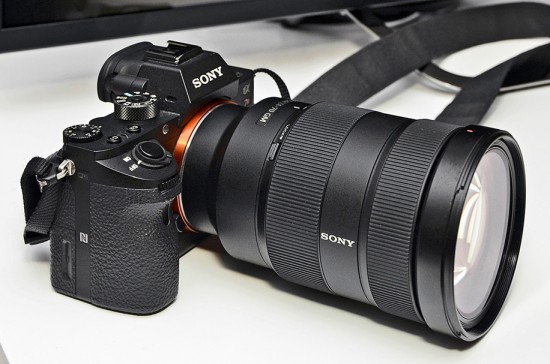
A reader sent me this hands-on with the latest Sony a6300 camera and G-Master FE 24-70mm f/2.8 GM lens from a recent event in Asia (the entire set of pictures can be accessed on flickr):
a. Despite having little experience with the previous NEX and current aXXXX lineup, I must agree that Sony has raised the bar in making the a6300, promising faster AF performance on a small camera package, better body build, and improved video capabilities. However, the insistence on Sony's (consumer-oriented) product positioning with the aXXXX models (as well as full-frame aX models), in terms of setting various limitations to the product line, means that the potential of the aXXXX is likely to be capped, thru deliberately omitting further pro-grade features and functionalities. For instance, I've been told global shutter technologies are not likely to be implemented on the aXXXX (or even the aX-series) in the near future, citing costs; The Face-Detect AF often seems to be biased towards the faces on the right hand side of the picture frame;
b. IMO, compared with the previous a6000, the a6300 feels just a tad faster in AF, despite the brand's flaunting of such new technology as 4D Focus, 425 phase detection AF points (only evident during certain AF mode/focus area operations), improved sensor readout technique etc.. Maybe I didn't get to try out all its AF modes and new focusing techniques, especially any on-demand lock-on AF modes, which is why. However, the difference in the additional focusing area selections can be confusing, as it would take patience and practice to determine which which focusing mode/area selection is best of which scenario. Also, not all focusing area selections are available in all focus modes (eg. certain lock-on AF tracking functions can be possible only under AF-C). But once this is figured out, the system works like a charm, so I'm convinced. Meanwhile, the lag-less EVF (ie. no black-out) view during continuous shooting is much appreciated, supported by good resolution and decent magnification, except for just two issues: slight barrel distortion with the view, and the diopter adjustment dial which is a bit flimsy and not easy to access; The hot shoe cover's fitment is a bit too tight.
c. The Custom 1 (C1) button next to the shutter is now defaulted to the new zoom focusing view mode, which I find not very useful. It is also disabled under AF-C. Even though custom buttons can be reassigned to different functions, IMO it would be more appropriate to default AF mode (as in a6000) and AF focus area selections to C1. Meanwhile, the rear C2 button is now defaulted to white balance setting, which I find appropriate, even though I would've preferred direct metering mode selection instead. The role of the Fn key (which points to quick camera function settings) remains unchanged;
d. The a6300 benefits from a compact but sturdy magnesium alloy construction, which also limits body color choice/config to just one simple black (in other words, no more unnecessary color scheme gimmick, let alone the previous a6000's white). However, despite Sony claiming to have better dust/moisture resistance, I suspect the side jack cover and bottom battery/card door may not have been reinforced with o-ring gaskets. The redesigned AF/MF/AEL button with flip switch is a welcoming gesture, also backed by various customization options with the button behavior (eg. toggle mode for both AEL and AF/MF, and vice versa); however, the flip switch itself feels a bit weak (especially when compared with the Olympus variety) so it needs to be reinforced in future model updates. But once again, users have to get accustomed to such custom button setting capabilities, or risk ending up with the default setting ie. depressing and holding the button which is especially inconvenient during AF/MF switchover. As with the previous a6000, the a6300's direct record button's awkward position remains unchanged, which again gets scrutinized by local media for being extremely inconvenient in actuation;
e. Sony's consumer-oriented market positioning with such product strategy has somewhat resulted in the relatively small form of the aXXXX series, which I must disagree on as having a small body with too many features can be frustrating to the average user, from the operational perspective which includes cluttered button arrangement within such small body, as well as having to dig into menu pages for accessing specific functions and settings. But OTOH, abundant reassignment capabilities of function/custom and other buttons can equally be messy.
Meanwhile, such small body form also limits (or even forbids) the deployment of better internal structures, such as a better shutter unit, sensor-based stabilization mecha, and implementation of additional accessory jacks. As addressed by some media, the meager 1/4000 shutter and 1/160 X-sync is little to be desired, while the inclusion of the mic-in jack is overshadowed by the lack of audio-out jack for effective monitoring, according to a certain newspaper photographer. The mic-in jack may allow for third-party microphone usage, but becomes redundant when Sony's own hotshoe-based XLR mic controller unit is used (even though such controller is a very good accessory, IMO). The camera's height is absolutely embarrassing, as it results a short grip (even molded) which yields discomfort when used in long duration, resulting in palm fatigue to certain degrees. Unfortunately such height has been fixated when Sony marketed the NEX6/7/a6000 previously, so altering the height seems to be awkward, even though I would like that to happen; say, at least increasing it by 0.5", or nearing the shoulder height of the a7/a7II series (ie. excluding the EVF). The a7II-series' grip is not perfect but is at least a bit more comfortable to hold then with the a6000/6300;
d. Contrary to earlier belief, the aXXXX and some earlier models can be configured to display histogram especially during EV shift. However this can be achieved only when the "Exposure Setting Guide" is switched off, the "Histogram" option is checked under the DISP setup, and the "Dial/Wheel EV Comp" is assigned to either the top right dial or rear scrollwheel (in other words, activating "easy exposure compensation" under Nikon speak). Otherwise, you'll end up with the usual EV sub-screen with an enlarged but cheesy orange EV scale. Perhaps the Exposure Setting Guide option should be abolished? Or, if this option needs to be retained, perhaps a repositioned and enlarged histo can be included -- or compulsory -- in the every instance of EV adjustment sub-screen, just like Ricoh did with the GR, or Nikon with its selective Coolpix compacts.
As a side note, per back-to-back testing, real-time histogram during EV shift CANNOT be achieved on the RX100m3/m4 when repeating the aforementioned steps. While the RX100m2 can achieve just that, not so on the m3 and m4; even with Exposure Setting Guide switched off and the EV function assigned to lens ring, the camera display still shows up a EV dial gauge, and of course, no histo. In addition, it appears that the rear scrollwheel cannot be reprogrammed in any way, let alone activating easy EV shift;
e. I have not thoroughly tested the camera's abundant video capabilities but I believe those improved AF speed and tracking features can be beneficial when shooting video, especially when the camera hardware is properly rigged and stabilized. Unfortunately due to Sony's red tape and other lame excuses such as market protection (or whatsoever), the system frequency change nag screen is here to stay. Fortunately, NTSC (60i) models now get an on-demand PAL mode and I only learned recently that this has been the case since the RX100m4 and A7II-series models, also exemplified by the lack of "50i/60i" designation on the underside product labels. Perhaps Sony wants this as a reminder to warn casual consumers when switching to the non-native video system frequency, but even so, that's just not necessary. Unfortunately to the Japanese customers, JDM version firmware appears to be still pure NTSC only and comes without the "NTSC/PAL Selector" menu option, as such topic is NOT covered in the Jap manual. (BTW, simply reading the instruction manual and help manual do not help understand the camera from an operational perspective; you'll have to have the camera and try every button, function etc. etc. to see for yourself.)
As a reminder, DEV-series digital binoculars, which are also AVCHD-compliant, have the true World Cam-style system frequency selection (ie. "50i/60i select") just like any other pro-grade video cams. And the DEV products are marketed as consumer products. As such I don't see why Sony should be insistent on giving consumers a confused (if not hard) time dealing with different video standards on their otherwise excellent camera hardware, especially if Panasonic doesn't do such trick on is GH4 (ie. unrestricted system frequency change among 50/59.94/24.00). Oh, speaking of Pana, perhaps they should start implementing World Cam video capabilities on the rest of its Lumix DC lineup as well;
f. The a6300 launch also featured of two of the G-Master lenses, the 85mm f/1.4 and 24-70mm f/2.8, while the remaining 70-200 f/2.8 was not available on-site and is said to have a delayed ETA. Both have been attached to a6300 sample bodies for photo taking but I didn't get the chance to test them as is, but that's OK, after all using these full-frame lenses on a 1.5x crop camera body would defeat the purpose of testing the lenses' true capabilities. But one thing is certain: the resulting camera config (ie. G-Master lenses attached to the a6300) appears grossly disproportionate. Eventually I was only able to test the latter on an a7R-II but even so I can feel the potential of the lens when it comes to image resolution, even at high ISOs. See the samples from the Mediafire uploads and see for yourself.
In conclusion, despite some drawbacks, IMO the a6300 is one of the best NEX (or aXXXX) models in the lineup. Just don't expect a full-frame aXXXX model (as Sony HK staff has stated that it's not very likely), or a higher-tier a7XXX, anytime soon. But for a picky customer like me, I wouldn't get one, at least not until Sony has improved the body size and ergonomics for a better grip, implemented a faster shutter (also with higher actuation ratings) as well as full electronic shutter, de-restricted the video system frequency selection, and removed some of the camera's redundant customization features.
On separate note, other products showcased included the latest lineup of action cams, as well as two current-spec Handycam models. But the latter is a turn off, as I don't see any new features and/or innovations being implemented in them. And the projector-equipped Handycam model is simply a joke. I'm just wondering, if a hi-am consumer is to shop for a new camcorder, what are the choices from Sony? I don't see any, and when I saw the AXP55 (4k, XAVC-S) I didn't even bother trying it out. The camcorder also feels much more plastic than previous models. Well, perhaps I should simply look into something like the PXW-X70 instead (even though 4k recording firmware is a paid option)?
Sample camera pics, sample pics of the G-Master 24-70 (shot on an a7RII), reportage pics, and a6300 camera manuals are available for download here.


